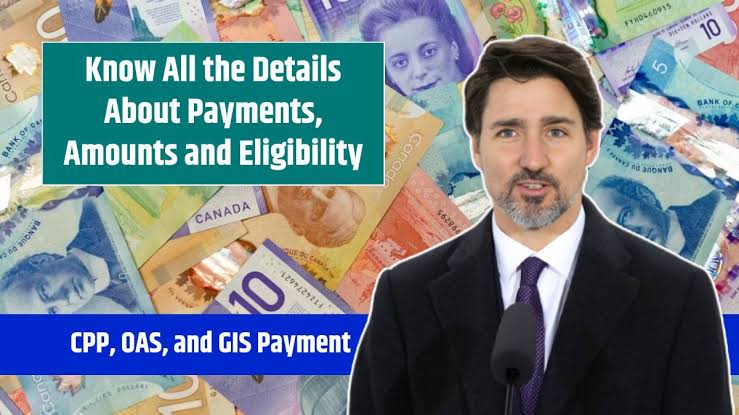The Canada Pension Plan (CPP) remains a vital support system for millions of Canadians entering retirement or facing long-term disability. From understanding eligibility to accessing your CPP account, and even navigating recent changes like its investment strategy shift, there’s a lot to unpack in 2025.
This article covers CPP payments, Old Age Pension in Canada, how to apply, login details, payment dates, and crucial updates affecting both residents and non-residents.

CPP, OAS, and GIS Payment Dates for 2025
What Is the Canada Pension Plan?
The Canada Pension Plan is a public retirement income program administered by the federal government. It provides monthly payments to eligible Canadians who have contributed to the plan during their working years. CPP covers:
- Retirement pensions
- Disability benefits
- Survivor’s pensions
- Children’s benefits
- Death benefits
Your eligibility and the amount you receive depend on how much you’ve contributed and for how long.
Canada Pension Plan Payments in 2025
CPP payments are typically adjusted annually to reflect inflation, and 2025 is no exception. The maximum monthly retirement pension for new recipients aged 65 is approximately $1,365.40 as of January 2025. However, most Canadians receive less — the average monthly amount is closer to $772.
When Are Canada Pension Plan Payments Made?
Payments are issued monthly, typically during the last week of each month. Here’s a quick snapshot of Canada Pension Plan payment dates for mid-year 2025:
- June 26, 2025
- July 29, 2025
- August 28, 2025
- September 25, 2025
These dates apply to both direct deposit and mailed cheques, though direct deposit is recommended for timely receipt.
Old Age Pension in Canada: How It Relates
Many people confuse CPP with Old Age Security (OAS), but these are two separate programs:
- CPP is based on contributions and work history.
- OAS is a taxable monthly benefit for Canadians aged 65 and older, regardless of work history, provided they meet residence requirements.
You can receive both CPP and OAS if you’re eligible, which significantly improves retirement income security.
CPP Eligibility: Residents and Non-Residents
One common question is: Can non-residents receive Canada Pension Plan benefits? The answer is yes — under certain conditions.
You can still receive CPP benefits if you live outside Canada, as long as:
- You’ve made at least one valid contribution to CPP.
- You meet the age or disability criteria.
However, tax implications may vary based on the tax treaty Canada holds with your country of residence. The CPP is also distinct from the Quebec Pension Plan (QPP), which applies to those who worked in Quebec.
Canada Pension Plan Application: How to Apply
To apply for CPP, you can:
- Apply online using your My Service Canada Account.
- Mail a paper application to Service Canada.
When Should You Apply?
The standard age to begin receiving CPP is 65, but you can start as early as 60 or as late as 70. Taking CPP earlier reduces your monthly amount, while delaying increases it.
Here’s how the early/late start impacts your benefit:
- Early (age 60–64): Reduced by 0.6% per month early (7.2% per year).
- Late (age 66–70): Increased by 0.7% per month delayed (8.4% per year).
Canada Pension Plan Login: Managing Your CPP Online
Accessing and managing your CPP is easy through the Canada Pension Plan login portal via My Service Canada Account (MSCA). You can:
- View payment dates and amounts
- Update banking and address information
- Track contributions and benefits
- Apply for benefits online
To create or log into your account, visit:
https://www.canada.ca/en/employment-social-development/services/my-account.html
If you need help with your login or other issues, the Canada Pension Plan phone number is 1-800-277-9914 (toll-free).
Investment Update: Why CPP Investments Dropped Its Net-Zero Target
In a headline-making move, Canada Pension Plan Investments (CPPI) announced in its 2025 Annual Report that it will no longer pursue a net-zero carbon emissions target by 2050.
According to CPPI CEO John Graham, the change comes in light of legal developments surrounding Canada’s Competition Act. These new laws require that all environmental claims be substantiated — creating stricter accountability for net-zero commitments.
“Recent legal developments in Canada have introduced new considerations around how net-zero commitments are interpreted,” said Graham. “But nothing has changed in terms of how we manage the portfolio.”
Still, the decision sparked backlash. Environmental advocates, like Shift Action for Pension Wealth and Planet Health, expressed deep concern, arguing that the move jeopardizes the future of Canadian retirees in the face of a worsening climate crisis.
Also read Tasmania’s EDGI Round 11: A Catalyst for Critical Mineral Exploration
CPP Performance Despite the Controversy
Even amidst controversy, CPP Investments reported a 9.3% net return for its latest fiscal year — just shy of its benchmark return of 10.9%.
With a fund size of over $630 billion, CPP remains one of the world’s largest pension plans. The fund’s diversified portfolio continues to invest across sectors and geographies, with sustainability still cited as a guiding principle.
Final Thoughts
The Canada Pension Plan remains a crucial pillar of retirement planning in Canada. Whether you’re nearing retirement, applying for the first time, or simply keeping track of payments, understanding the system can help you make smarter financial decisions.
Despite concerns over its investment direction, CPP continues to provide stable, inflation-adjusted income to millions. Whether you’re a resident or abroad, it’s important to stay informed about your rights, eligibility, and benefits.

